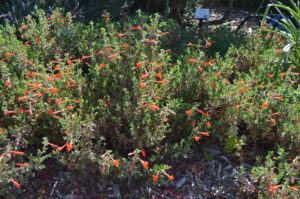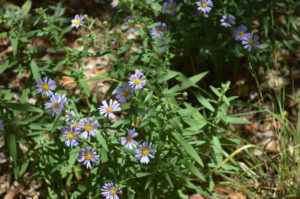California Native Plants for Your Garden
There are numerous advantages to growing native plants in your garden. They offer food and shelter to wildlife and help to maintain delicate ecosystems. You can find native plants that are hardy in any of California’s wide range of climates and are well adapted to surviving and thriving with native soils, pollinators, and pests.
Beyond all that, you can use native plants to meet certain needs or work with particular garden conditions. Check out the following native plant recommendations for water-wise gardens; rain gardens; container gardens; deer resistance; slope stabilization; and gardening in sun, shade, sandy soil, or clay soil.
Water-Wise Gardens
Many native plants have adapted to California’s dry summers and will thrive in a low-water garden. Here are a few of the more colorful and easy-to-grow options:
- California poppy (Eschscholzia californica)
- Desert beard tongue (Penstemon pseudospectabilis)
- Desert mallow (Sphaeralcea ambigua)
- Pink flowering currant (Ribes sanguinium glutinosum)
- Wild lilac (Ceanothus)
Rain Gardens
For areas with higher average rainfall or gardens with poorly draining soil, look to the California native plants that are adapted to riparian (river-adjacent) or other wet environments, such as the following:
- California pipevine (Aristolochia californica)
- California fan palm (Washingtonia filifera)
- Leopard lily (Lilium pardalinum)
- Deer grass (Muhlenbergia rigens)
- Western spicebush (Calycanthus occidentalis)
- California gray rush (Juncus patens)
Container Gardens
For container gardens, look for plants that offer bursts of colorful blooms or striking foliage that can look great in combination with other plants and that can handle the periods of dry soil that container-grown plants often have to endure. Here are a few to try:
- Baby blue eyes (Nemophila menziesii)
- Blue-eyed grass (Sisyrinchium bellum)
- Coastal woodfern (Dryopteris arguta)
- Lewisia (Lewisia cotyledon)
- Thimbleberry (Rubus parviflora)
Deer Resistance
Deer have particular feeding preferences, so to create a deer-resistant garden you need to install plants that have opposite characteristics. They prefer leaves that are tender, green, and juicy, so using native plants that are tough, prickly, spiny or fuzzy will usually deter them. They also tend to avoid plants that are toxic or that contain aromatic oils. Here are some of the native plants that deer are likely to leave alone:
- California bush anemone (Carpenteria californica)
- California holly grape (Berberis pinnata)
- Fuchsia-flowered gooseberry (Ribes speciosum)
- Manzanita (Arctostaphylos spp.)
- Sage (Salvia spp.)
Slope Stabilization
When planting slopes, you need to consider both erosion control and fire resistance. Look for ground cover plants that are deep-rooted to hold onto the soil and low-growing so that winds are less able to whip up and spread higher flames in a fire. These native plants are good choices for dry, sunny slopes:
- Dana Point California buckwheat (Eriogonum fasciulatum ‘Dana Point’)
- Pigeon Point Coyote brush (Baccharis pilularis ‘Pigeon Point’)
- Mrs. Beard creeping sage (Salvia sonomensis ‘Mrs. Beard’)
- John Dourley manzanita (Arctostaphylos spp. ‘John Dourley’)
Sun and Soil Conditions
The following native plants are well adapted to particular sun and soil conditions.
- Sun

- Bush monkeyflower (Mimulus aurantiacus)
- California fuchsia (Epilobium canum)
- Cleveland’s sage (Salvia clevelandii)
- Coyote mint (Monardella odoratissima)
- Foothill penstemon (Penstemon heterohyllus)
- Shade
- Humboldt lily (Lilium humboldtii)
- Redtwig dogwood (Cornus sericea)
- Western sword fern (Polystichum munitum)
- Wild ginger (Asarum lemmonii or A. caudatum)
- Wild iris hybrids (Iris ‘Pacific Coast’ hybrids)
- Sandy Soil
- Aster (Aster chilensis)
- Beach strawberry (Fragaria chiloensis)
- Live forever (Dudleya hassei)
- Purple sage (Salvia leucophylla)
- Sea thrift (Armeria maritima)
- Clay Soil
For more information on selecting native plants for your California garden, check out the California Native Plant Society.

